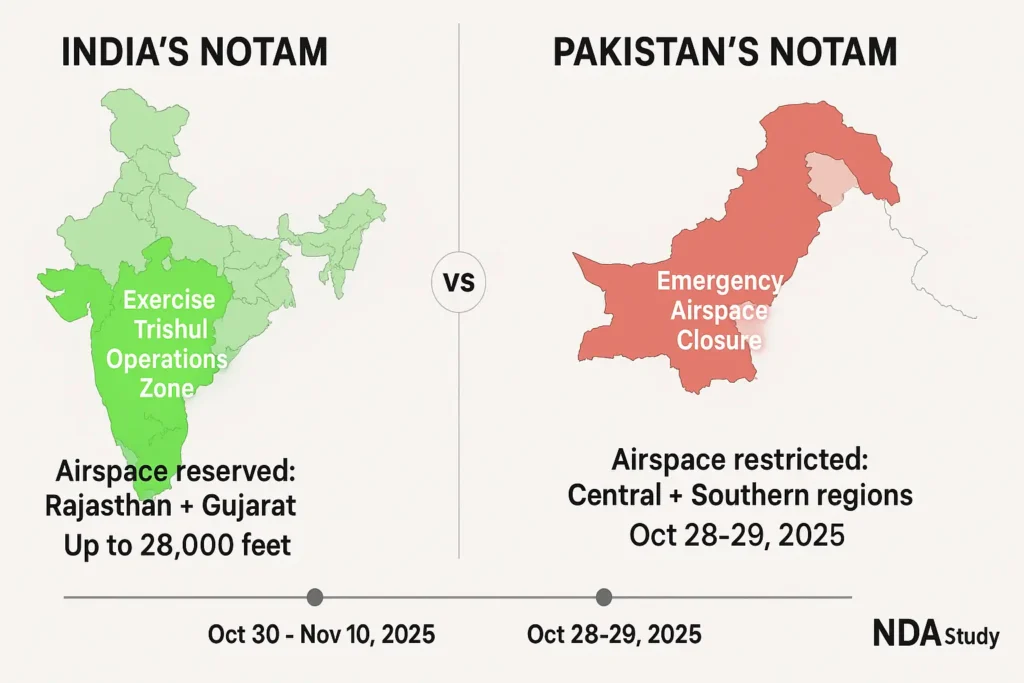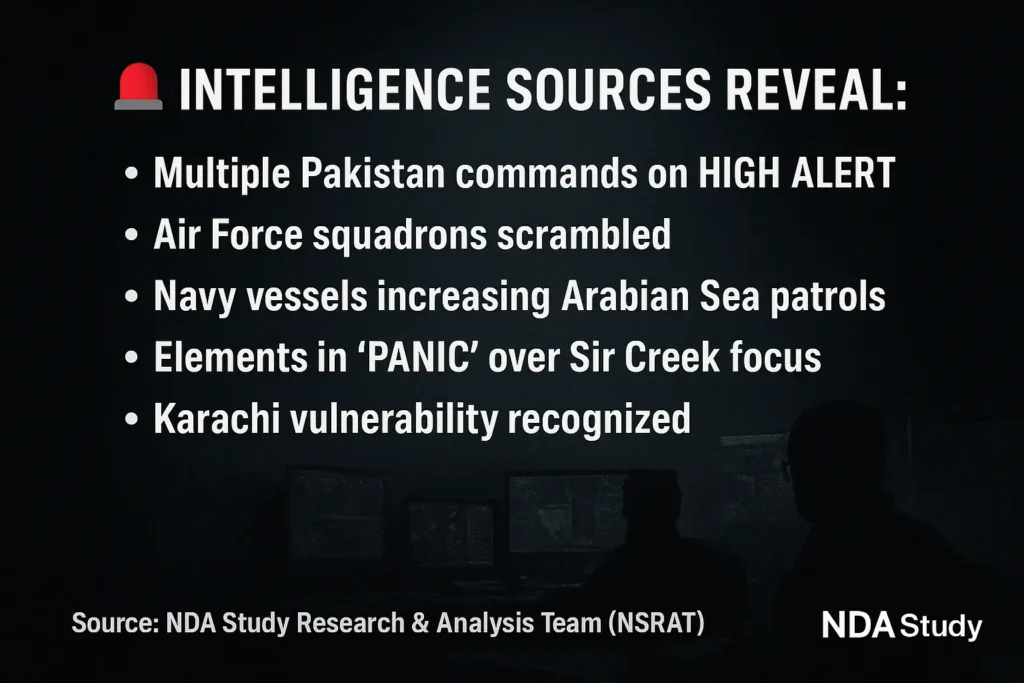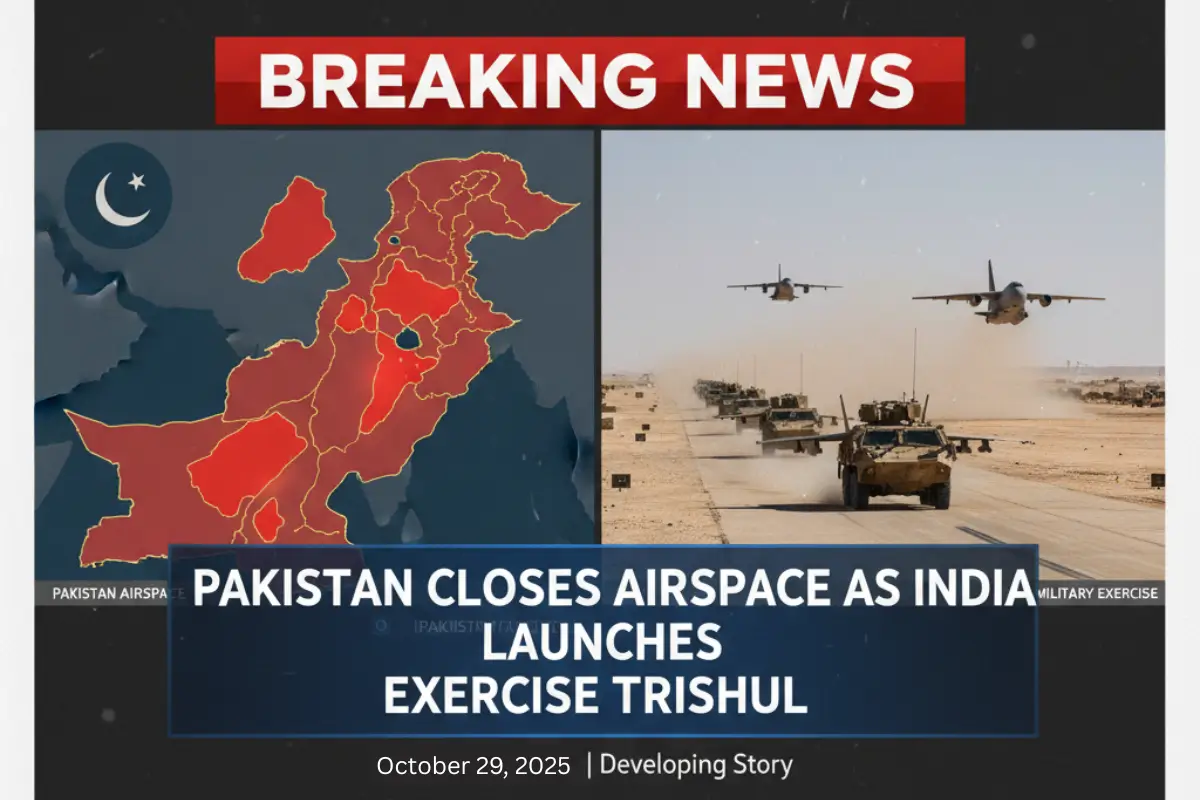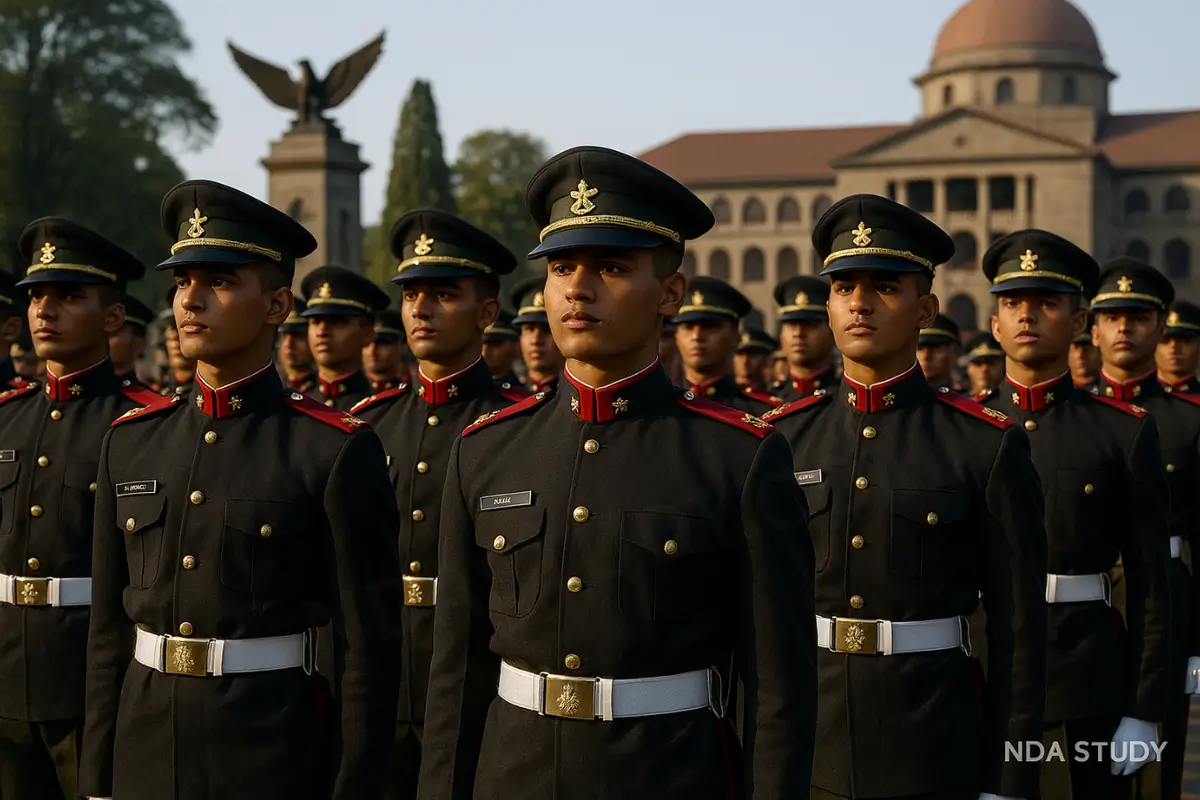Pakistan has restricted its airspace in the central and southern regions as India launches Exercise Trishul 2025. This military drill starts in 48 hours and will be the largest tri-services exercise in 2025. India plans to use over 20,000 troops, Rafale jets, and warships along its western border. Pakistan’s decision shows its concerns about regional security and prepares for possible threats, especially in the important Sir Creek area.
Analysts say these military actions indicate a stronger urgency to respond to India’s plans. Although these movements raise concerns, they also provide a chance for both countries to communicate better. Talking about military exercises and security issues can help reduce tensions and lead to a more stable and peaceful region.
Table of Contents
Pakistan’s Emergency Airspace Lockdown: What’s Happening Right Now
In an unprecedented move that has sent shockwaves through regional security circles, Pakistan issued a Notice to Airmen (NOTAM) on October 28-29, 2025, restricting multiple air traffic routes across its central and southern airspace. Commercial airlines have been forced to divert flights, causing disruptions across South Asia’s busiest air corridors.

While Pakistani authorities have provided no official explanation for the airspace closure, the timing is unmistakable. The restrictions come exactly two days before India’s Exercise Trishul – a massive 12-day tri-services combat exercise scheduled from October 30 to November 10, 2025, along the Pakistan border.
Defence intelligence sources speaking to CNN-News18 revealed that multiple Pakistani military commands and airbases have been placed on high alert, with Air Force squadrons scrambled and Navy vessels increasing patrols in the Arabian Sea. According to these sources, elements within Pakistan’s defence establishment are reportedly “in panic” over India’s military drill focused on the Sir Creek-Sindh-Karachi axis.
The Scale of Pakistan’s Response
Pakistan’s airspace restrictions extend across:
- Central regions: Including areas around Multan, Bahawalpur, and Rahim Yar Khan
- Southern sectors: Covering Sindh province, particularly the airspace near Karachi and the coastal belt
- Duration: Initially announced for 48 hours (October 28-29), but military sources suggest restrictions could be extended
This represents one of Pakistan’s most extensive peacetime airspace closures since the February 2019 Balakot crisis, when both nations engaged in aerial combat following India’s strikes against terror camps.
India’s Exercise Trishul: The Military Drill That Triggered Pakistan’s Panic
What exactly has prompted such a dramatic Pakistani response? The answer lies in the unprecedented scale and strategic focus of India’s Exercise Trishul 2025.
Massive Deployment Along Western Border
India issued its own NOTAM on October 24, 2025, reserving airspace up to 28,000 feet across Rajasthan and Gujarat from October 30 to November 10. Satellite imagery analyst Damien Symon described the area and scale of operations as “unusual,” suggesting this represents one of India’s largest military exercises in recent years.
The numbers tell the story:
- Over 20,000 troops were deployed from the Indian Army, Navy, and Air Force
- T-90 Bhishma and Arjun Mark-II main battle tanks positioning in desert sectors
- Rafale and Sukhoi-30MKI fighter jets are conducting high-tempo operations
- Naval frigates and destroyers deployed off Gujarat’s Saurashtra coast
- IL-78 aerial refuelers and AWACS aircraft provide force multiplication
The Sir Creek Factor: Why This Location Matters
Exercise Trishul’s strategic focus on the Sir Creek region represents the core of Pakistan’s anxiety. Sir Creek, a 96-kilometre tidal estuary between Gujarat’s Rann of Kutch and Pakistan’s Sindh province, is not just a disputed territory – it’s Pakistan’s strategic Achilles heel.
Access to Karachi: The Sir Creek-Sindh-Karachi belt represents Pakistan’s economic lifeline. Karachi handles 95% of Pakistan’s seaborne trade and hosts critical naval assets. Military operations in Sir Creek could potentially isolate Karachi, disrupting Pakistan’s entire economy.
Weakest Military Sector: Unlike the heavily fortified Punjab border (Lahore-Sialkot axis), Pakistan’s southern Sindh coast has historically received less military attention and infrastructure investment. Pakistani military planners recognise this vulnerability, making India’s focus on Sir Creek particularly alarming.
Maritime Dominance: Control over Sir Creek determines maritime boundaries in the Arabian Sea, affecting Exclusive Economic Zone (EEZ) claims, access to oil and gas reserves, and fishing rights in some of Asia’s richest waters.
Rajnath Singh’s Warning: The Message That Changed Everything
Exercise Trishul didn’t materialise in a vacuum. It follows Defence Minister Rajnath Singh’s stern warning to Pakistan delivered during his Dussehra address at the Indian Air Force base in Bhuj on October 3, 2025.
“If Pakistan dares to act in the Sir Creek sector, the reply will be so strong that it will CHANGE BOTH HISTORY AND GEOGRAPHY.”
Rajnath Singh – Defence Minster of India
Cautioning Islamabad against any “misadventure” in the Sir Creek area, Singh declared: “If Pakistan dares to act in the Sir Creek sector, the reply will be so strong that it will change both history and geography.”
This unusually blunt language marked a significant departure from India’s typically measured diplomatic rhetoric. The statement carried implicit threats:
- “Change history”: Suggesting potential territorial changes or a lasting strategic defeat for Pakistan
- “Change geography”: Hinting at military operations that could redraw borders or alter ground realities
Coming from India’s Defence Minister – the civilian authority overseeing the Armed Forces – this wasn’t empty political rhetoric. It was a policy statement backed by military capability, and Exercise Trishul is the demonstration of that capability.
Pakistan Navy Chief’s Provocative Sir Creek Visit
Adding fuel to the fire, Pakistan Navy Chief Admiral Naveed Ashraf conducted a high-profile visit to forward posts in Sir Creek on October 24-25, 2025, the exact timing of India’s NOTAM announcement for Exercise Trishul.
During this visit, Admiral Ashraf:
- Inducted three new 2400 TD hovercrafts into the Pakistan Marines
- Inspected forward observation posts and coastal defences
- Declared Pakistan Navy “ready to defend every inch from Sir Creek to Jiwani”
- Supervised training exercises in creek operations
Indian intelligence agencies assessed this visit as a “deliberate provocation” timed to coincide with India’s military preparations. However, analysts also note that the hovercraft induction represents Pakistan’s attempt to upgrade defensive capabilities in a sector where it lacks conventional military strength.
The China Connection
Pakistan’s sensitivity about Sir Creek also relates to Chinese strategic interests. The China-Pakistan Economic Corridor (CPEC) relies on secure southern maritime routes, with the port of Gwadar (approximately 300 kilometres west of Karachi) serving as China’s gateway to the Arabian Sea.
Any instability in Pakistan’s southern maritime regions threatens Chinese investments and strategic interests. Some analysts suggest China may have quietly advised Pakistan to demonstrate resolve in Sir Creek, explaining Admiral Ashraf’s high-profile visit and the subsequent airspace restrictions.
What’s Actually Happening in Exercise Trishul: Ground Reports
As Exercise Trishul unfolds, here’s what’s happening across different operational theatres:
Desert Warfare: Rajasthan Sector
The Bhopal-based 21 Corps (Sudarshan Chakra Corps), one of India’s three offensive strike corps, is conducting large-scale armoured manoeuvres in the Jaisalmer-Barmer desert region. Locals report:
- Massive convoys of tanks and armoured vehiclesare moving toward forward positions
- Artillery units establishing gun positions in the desert
- Attack helicopter squadrons conducting day and night operations
- Troops practising rapid mobilisation drills
Amphibious Operations: Gujarat Coast
Off the Saurashtra coast in Gujarat, the Indian Navy is rehearsing amphibious assault operations:
- Landing craft deploying troops and armoured vehicles to beaches
- Marine Commandos (MARCOS) conducting special operations drills
- Frigate and destroyer flotillas providing offshore fire support
- Coordination with Army units for integrated beach assault scenarios
These operations are particularly relevant to Sir Creek’s tidal creek environment, where conventional ground forces cannot operate without specialised amphibious capabilities.
Air Operations: Mahagurjar Exercise
The Indian Air Force component, code-named “Mahagurjar,” features:
- Rafale jets from Hasimara and Ambala are conducting precision strike missions
- Sukhoi-30MKI fighters demonstrating long-range strike capabilities
- IL-78 mid-air refuelling tankers enabling extended operations
- AWACS aircraft coordinating air operations and monitoring Pakistani airspace
- UAVsare conducting persistent surveillance along the border
Flight tracking data shows unprecedented levels of Indian Air Force activity over Gujarat and Rajasthan, with commercial pilots reporting frequent military aircraft movements.
The Operation Sindoor Connection: Context Matters
To understand why Exercise Trishul has triggered such intense Pakistani anxiety, we must examine the events of May 2025 – Operation Sindoor.

From Pahalgam Massacre to Military Response
On April 22, 2025, Pakistan-based terrorists launched a devastating attack on Pahalgam in Jammu and Kashmir, killing 26 civilians, including women and children. This massacre triggered national outrage in India and set in motion a chain of events that changed the India-Pakistan strategic equation.
From May 7-10, 2025, India conducted Operation Sindoor – the most extensive cross-border military action since the 1971 war. Indian Armed Forces:
- Destroyed nine terror camps deep inside Pakistan and Pakistan-occupied Kashmir
- Struck 11 Pakistani airbases and radar installations
- Conducted precision strikes using BrahMos cruise missiles, Spice-2000 bombs, and other advanced weapons
- Demonstrated unprecedented tri-services coordination
The Four-Day War
The four-day India-Pakistan conflict in May 2025 brought the two nuclear-armed neighbours to the brink. Pakistan attempted limited retaliatory strikes, but India’s air defence systems (particularly Akash missiles) successfully intercepted Pakistani JF-17 fighters.
The conflict ended on May 10, 2025, with a ceasefire brokered through the DGMO (Director General of Military Operations) hotline, facilitated by US President Donald Trump’s mediation efforts. However, the ceasefire didn’t resolve underlying tensions – it merely paused active hostilities.
Why Operation Sindoor Makes Exercise Trishul More Alarming
This capability to conduct sustained, large-scale military operations fundamentally changes the strategic calculus. Pakistan can no longer assume that supporting terrorism carries a limited risk of Indian military response, or that such responses will be one-time events allowing Pakistan to rebuild and resume operations.
For Pakistan’s military planners, Exercise Trishul represents a terrifying possibility: India can repeat Operation Sindoor-scale operations not just once, but repeatedly and sustainably. The exercise demonstrates that India’s military didn’t exhaust its operational capacity during Sindoor but can conduct even larger operations just months later.
Pakistan’s Military Dilemma: Stretched Thin and Vulnerable
Pakistan faces several strategic challenges that Exercise Trishul exposes:
Geographic Vulnerability
Pakistan’s military forces are primarily concentrated along:
- Punjab sector: Defending Lahore and Sialkot against India’s Western Command
- Kashmir sector: Engaging with Indian forces along the Line of Control
- Afghanistan border: Dealing with Tehrik-i-Taliban Pakistan (TTP) insurgency
- Balochistan: Countering separatist movements
This leaves the Sindh coast and Sir Creek region comparatively under-defended. Reinforcing this sector means weakening defences elsewhere, creating a strategic dilemma.
Naval Inferiority
The Pakistan Navy is significantly weaker than the Indian Navy:
- India: 2 aircraft carriers, 10 destroyers, 12 frigates, 16 corvettes, 1 nuclear submarine, 16 conventional submarines
- Pakistan: 0 aircraft carriers, 0 destroyers, 10 frigates, 0 corvettes, 0 nuclear submarines, 8 conventional submarines
In any Sir Creek or Arabian Sea confrontation, Pakistan lacks the naval assets to effectively challenge Indian maritime dominance. This explains Admiral Ashraf’s emphasis on asymmetric capabilities like hovercrafts and coastal defences.
Economic Constraints
Pakistan’s economy remains fragile, with:
- High inflation and currency depreciation
- Dependence on IMF loans and Saudi/UAE bailouts
- The limited defence budget is unable to match the Indian military’s modernisation
- CPEC debt obligations to China
These economic constraints limit Pakistan’s ability to sustain prolonged high-alert military postures or conduct expensive military exercises matching India’s scale.
The JAI Vision: India’s New Defence Paradigm
Exercise Trishul showcases Prime Minister Narendra Modi’s JAI vision for the Armed Forces: Jointness, Atmanirbharta (self-reliance), and Innovation.
Jointness: Tri-Services Integration
Unlike past exercises where the Army, Navy, and Air Force operated semi-independently, Exercise Trishul features genuine integration:
- Unified command and control through Southern Command headquarters
- Real-time intelligence sharing across services
- Coordinated strike packages combining air, land, and sea assets
- Joint logistics and communications infrastructure
This level of jointness represents a preview of India’s future Theatre Command structure, where services will operate under unified commanders rather than maintaining separate operational spheres.
Atmanirbharta: Indigenous Weapons Dominance
Exercise Trishul prominently features indigenous weapons systems:
- Akash surface-to-air missiles (successfully combat-proven during Operation Sindoor)
- BrahMos supersonic cruise missiles
- Nagastra-I loitering munitions (kamikaze drones)
- DRDO Netra airborne early warning aircraft
- Rudra and Prachand attack the helicopters
According to Ministry of Defence statements, over 85% of weapons systems deployed in Exercise Trishul are manufactured in India, compared to less than 40% a decade ago. This self-reliance reduces dependency on foreign suppliers and enables rapid wartime sustainment.
Innovation: Network-Centric Warfare
Exercise Trishul tests cutting-edge concepts:
- Exercise Agni Drishti: Integrating land, air, space, and unmanned ISR assets into unified sensor-to-shooter grids
- Exercise Trinetra: Electromagnetic spectrum operations and counter-drone warfare
- Cyber Operations: Offensive and defensive cyber capabilities integrated into operational planning
- AI-enabled Targeting: Machine learning algorithms processing sensor data for faster target identification
These innovations reflect lessons from recent conflicts in Ukraine, Gaza, and Azerbaijan, where drone swarms, electronic warfare, and cyber attacks have transformed modern battlefield dynamics.
International Reactions: Who’s Saying What
United States: Urging Restraint
The Biden administration (in its final months) has urged both India and Pakistan to exercise restraint and maintain the May 2025 ceasefire. However, US statements have been notably more supportive of India’s position:
- Recognising India’s “right to self-defence against terrorism”
- Declining to condemn Operation Sindoor as “disproportionate”
- Calling on Pakistan to “take demonstrable action against terror groups”
US President Donald Trump, who mediated the May ceasefire, has been uncharacteristically quiet about Exercise Trishul, possibly signalling American acceptance of India’s military posturing as legitimate deterrence.
China: Watching Silently
China’s official response has been limited to generic calls for “peace and stability in South Asia.” However, Chinese military movements suggest concern:
- Increased PLA Navy presence in the Arabian Sea and Indian Ocean
- Enhanced satellite surveillance of Indian military exercises
- Possible intelligence sharing with Pakistan about Indian force deployments
China faces a dilemma: supporting Pakistan risks antagonising India (with whom China has its own border disputes), while abandoning Pakistan could undermine China’s regional influence and jeopardise CPEC investments.
Russia: Balancing Act
Russia, a traditional Indian defense partner now also courting Pakistan, has adopted studied neutrality. Moscow continues to supply weapons to India while expanding defence cooperation with Pakistan, attempting to maintain influence with both rivals.
Gulf States: Quiet Mediation
Saudi Arabia and the United Arab Emirates have reportedly conducted quiet diplomacy, urging both India and Pakistan to avoid escalation. Both Gulf nations maintain strong economic ties with India while preserving historical links with Pakistan, giving them credibility as potential mediators.
What Happens Next: Possible Scenarios
As Exercise Trishul unfolds from October 30 to November 10, several scenarios could develop:
Scenario 1: Successful Deterrence (Most Likely)
Exercise Trishul achieves its primary objective – demonstrating Indian military capability and operational readiness, thereby deterring Pakistani support for terrorism. Pakistan maintains high alert status but avoids provocative actions, and tensions gradually decrease after the exercise concludes.
Probability: 70%
Scenario 2: Minor Border Incidents (Moderate Probability)
Heightened tensions lead to localised skirmishes along the Line of Control or Sir Creek, possibly involving:
- Artillery exchanges
- Small arms fire between border patrols
- Ceasefire violations by either side
- Drone incursions
These incidents remain contained without escalating to broader conflict, similar to periodic flare-ups that have occurred since May 2025.
Probability: 25%
Scenario 3: Major Escalation (Low but Non-Zero Probability)
An unintended incident (military accident, miscommunication, or deliberate provocation) triggers broader military engagement:
- Airspace violations leading to aerial combat
- Naval confrontations in the Arabian Sea
- Terror attacks inside India are prompting a military response
- Cyber attacks on critical infrastructure
While both nations have strong incentives to avoid full-scale war, the concentration of military forces and heightened alert status increases the risk of escalation from miscalculation.
Probability: 5%
For NDA Aspirants: Key Points to Remember
Dates and Duration:
- Exercise Trishul: October 30 – November 10, 2025 (12 days)
- India’s NOTAM: October 24, 2025 (airspace reserved up to 28,000 feet)
- Pakistan’s NOTAM: October 28-29, 2025 (airspace restrictions)
Key Military Units:
- 21 Corps (Sudarshan Chakra Corps) – Bhopal-based strike corps
- Southern Command – Overall exercise coordination
- IAF Mahagurjar operations – Air Force component
Geographic Focus:
- Sir Creek (96 km tidal estuary between Gujarat and Sindh)
- Rajasthan desert sector (Jaisalmer-Barmer region)
- Saurashtra coast (amphibious operations)
Strategic Context:
- Follows Operation Sindoor (May 7-10, 2025)
- Response to Pahalgam terror attack (April 22, 2025)
- Demonstrates PM Modi’s JAI vision (Jointness, Atmanirbharta, Innovation)
Indigenous Systems Deployed:
- Akash surface-to-air missiles
- BrahMos cruise missiles
- Nagastra-I loitering munitions
- DRDO Netra AEW&C aircraft
Pakistan’s Response:
- Airspace restrictions (October 28-29)
- High alert for military commands
- Navy Chief’s Sir Creek visit (October 24-25)
- Induction of hovercrafts into the Pakistan Marines
Conclusion: A Defining Moment in India-Pakistan Relations
As India’s Exercise Trishul unfolds and Pakistan responds with airspace lockdowns and high alert status, South Asia stands at a critical juncture. The exercise represents more than military training – it’s a statement of strategic intent that fundamentally alters the India-Pakistan security dynamic.
For India, Exercise Trishul demonstrates that Operation Sindoor wasn’t an anomaly but a capability that can be sustained and repeated. The focus on Sir Creek signals strategic flexibility, forcing Pakistan to defend vulnerable sectors rather than concentrating on traditional flashpoints.
For Pakistan, the exercise exposes uncomfortable realities: military inferiority relative to India, economic constraints limiting defence spending, and strategic vulnerabilities in southern maritime regions that threaten national economic lifelines.
The question now is whether this display of military capability achieves its deterrent objective – discouraging Pakistani support for terrorism without requiring these weapons to be used in actual combat. The answer will determine whether South Asia moves toward greater stability or another devastating conflict.
As Exercise Trishul continues, one thing is certain: the strategic landscape in South Asia has irrevocably changed, and both nations must navigate this new reality with wisdom, restraint, and recognition of the catastrophic costs of miscalculation.
Stay Tuned & Stay Connected!
– NDA Study





